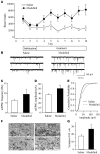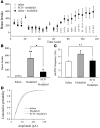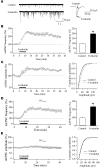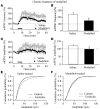Prolonged wakefulness induces experience-dependent synaptic plasticity in mouse hypocretin/orexin neurons
- PMID: 18060037
- PMCID: PMC2104495
- DOI: 10.1172/JCI32829
Prolonged wakefulness induces experience-dependent synaptic plasticity in mouse hypocretin/orexin neurons
Abstract
Sleep is a natural process that preserves energy, facilitates development, and restores the nervous system in higher animals. Sleep loss resulting from physiological and pathological conditions exerts tremendous pressure on neuronal circuitry responsible for sleep-wake regulation. It is not yet clear how acute and chronic sleep loss modify neuronal activities and lead to adaptive changes in animals. Here, we show that acute and chronic prolonged wakefulness in mice induced by modafinil treatment produced long-term potentiation (LTP) of glutamatergic synapses on hypocretin/orexin neurons in the lateral hypothalamus, a well-established arousal/wake-promoting center. A similar potentiation of synaptic strength at glutamatergic synapses on hypocretin/orexin neurons was also seen when mice were sleep deprived for 4 hours by gentle handling. Blockade of dopamine D1 receptors attenuated prolonged wakefulness and synaptic plasticity in these neurons, suggesting that modafinil functions through activation of the dopamine system. Also, activation of the cAMP pathway was not able to further induce LTP at glutamatergic synapses in brain slices from mice treated with modafinil. These results indicate that synaptic plasticity due to prolonged wakefulness occurs in circuits responsible for arousal and may contribute to changes in the brain and body of animals experiencing sleep loss.
Figures








Comment in
-
Staying awake puts pressure on brain arousal systems.J Clin Invest. 2007 Dec;117(12):3648-50. doi: 10.1172/JCI34250. J Clin Invest. 2007. PMID: 18060024 Free PMC article.
Similar articles
-
Staying awake puts pressure on brain arousal systems.J Clin Invest. 2007 Dec;117(12):3648-50. doi: 10.1172/JCI34250. J Clin Invest. 2007. PMID: 18060024 Free PMC article.
-
Regulation of synaptic efficacy in hypocretin/orexin-containing neurons by melanin concentrating hormone in the lateral hypothalamus.J Neurosci. 2008 Sep 10;28(37):9101-10. doi: 10.1523/JNEUROSCI.1766-08.2008. J Neurosci. 2008. PMID: 18784290 Free PMC article.
-
Repeated in vivo exposure of cocaine induces long-lasting synaptic plasticity in hypocretin/orexin-producing neurons in the lateral hypothalamus in mice.J Physiol. 2013 Apr 1;591(7):1951-66. doi: 10.1113/jphysiol.2012.246983. Epub 2013 Jan 14. J Physiol. 2013. PMID: 23318871 Free PMC article.
-
Plasticity in neurons synthesizing wake/arousal promoting hormone hypocretin/orexin.Vitam Horm. 2012;89:35-59. doi: 10.1016/B978-0-12-394623-2.00003-2. Vitam Horm. 2012. PMID: 22640607 Review.
-
Action of modafinil through histaminergic and orexinergic neurons.Vitam Horm. 2012;89:259-78. doi: 10.1016/B978-0-12-394623-2.00014-7. Vitam Horm. 2012. PMID: 22640618 Review.
Cited by
-
A dynamical role for acetylcholine in synaptic renormalization.PLoS Comput Biol. 2013;9(3):e1002939. doi: 10.1371/journal.pcbi.1002939. Epub 2013 Mar 14. PLoS Comput Biol. 2013. PMID: 23516342 Free PMC article.
-
A neuromorphic architecture for object recognition and motion anticipation using burst-STDP.PLoS One. 2012;7(5):e36958. doi: 10.1371/journal.pone.0036958. Epub 2012 May 15. PLoS One. 2012. PMID: 22615855 Free PMC article.
-
Sleep and synaptic renormalization: a computational study.J Neurophysiol. 2010 Dec;104(6):3476-93. doi: 10.1152/jn.00593.2010. Epub 2010 Oct 6. J Neurophysiol. 2010. PMID: 20926617 Free PMC article.
-
Dynamics of spontaneous activity in random networks with multiple neuron subtypes and synaptic noise : Spontaneous activity in networks with synaptic noise.J Comput Neurosci. 2018 Aug;45(1):1-28. doi: 10.1007/s10827-018-0688-6. Epub 2018 Jun 19. J Comput Neurosci. 2018. PMID: 29923159 Free PMC article.
-
The neurobiology of modafinil as an enhancer of cognitive performance and a potential treatment for substance use disorders.Psychopharmacology (Berl). 2013 Oct;229(3):415-34. doi: 10.1007/s00213-013-3232-4. Epub 2013 Aug 10. Psychopharmacology (Berl). 2013. PMID: 23934211 Free PMC article. Review.
References
-
- Tononi G., Cirelli C. Sleep function and synaptic homeostasis. Sleep Med. Rev. 2006;10:49–62. - PubMed
-
- Rechtschaffen A., Bergmann B.M., Everson C.A., Kushida C.A., Gilliland M.A. Sleep deprivation in the rat: X. Integration and discussion of the findings. Sleep. 1989;12:68–87. - PubMed
-
- Bonnet M.H., Arand D.L. Clinical effects of sleep fragmentation versus sleep deprivation. Sleep Med. Rev. 2003;7:297–310. - PubMed
-
- Durmer J.S., Dinges D.F. Neurocognitive consequences of sleep deprivation. Semin. Neurol. 2005;25:117–129. - PubMed

